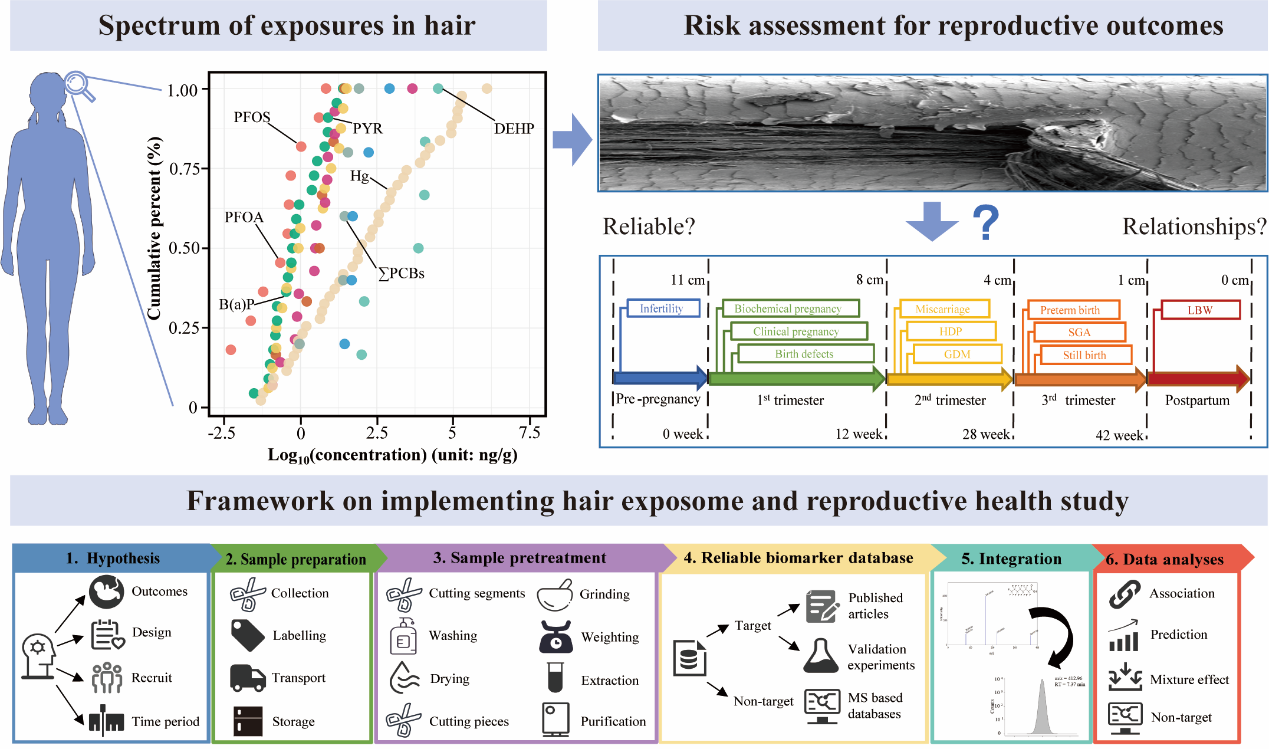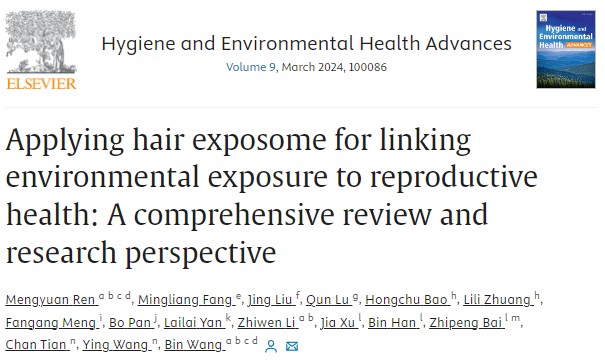
Featured research
HEHA | Applying Hair Exposome for Linking Environmental Exposure to Reproductive Health: A Comprehensive Review and Research Perspective
Applying Hair Exposome for Linking Environmental Exposure to Reproductive Health: A Comprehensive Review and Research Perspective
The research team led by Professor Bin Wang from Peking University, in collaboration with multidisciplinary teams from Fudan University, Zhejiang University, Chinese Research Academy of Environmental Sciences, Kunming University of Science and Technology, Peking University Third Hospital, Capital Medical University, Yantai Yuhuangding Hospital, and the University of Washington, has published a review article titled "Applying hair exposome for linking environmental exposure to reproductive health: A comprehensive review and research perspective" in the journal Hygiene and Environmental Health Advances (HEHA). There is substantial evidence indicating that various environmental exposure factors have significant impacts on reproductive health. With the advancement of exposomics research, the analysis of hair exposome to explore the relationships between environmental factors and reproductive health outcomes shows notable application potential. This review summarizes the latest research progress and advantages in using hair exposomics to assess the relationship between environment and reproductive health, evaluates the reliability of exposure biomarkers in hair, and proposes a general framework for conducting reproductive health research using hair exposomics.

Figure 1. Graphical Abstract
Paper type: Review
First affiliated institution: Peking University
First author: Mengyuan Ren
Corresponding authors: Bin Wang (Peking University)
Journal: Hygiene and Environmental Health Advances
Article information: Ren M, Fang M, Liu J, Lu Q, Bao H, Zhuang L, Meng F, Pan B, Yan L, Li Z, Xu J, Han B, Bai Z, Tian C, Wang Y, Wang B*. Applying Hair Exposome for Linking Environmental Exposure to Reproductive Health: A Comprehensive Review and Research Perspective, Hygiene and Environmental Health Advances, 2024, 9, 100086. https://doi.org/10.1016/j.heha.2023.100086
Main page: https://www.sciencedirect.com/science/article/pii/S2773049223000429

Research has shown that the environment and its interaction with genetic factors have significant impacts on human health. However, in the real world, multiple environmental factors interact, and their exposure characteristics dynamically change over time, resulting in highly complex exposure scenarios. This complexity poses significant challenges for assessing the impact of environmental factors on human health. Exposomics has emerged as an important research method to reveal key environmental factors influencing disease occurrence and to predict their effects on endogenous biological processes, phenotypes, and diseases in the human body. Selecting appropriate biomarkers is crucial for conducting human health risk assessment studies from the perspective of exposomics. Hair samples have been used in numerous studies to assess human exposure characteristics. To date, a large number of environmental exposure substances have been detected in hair samples, including both external and endogenous exposures such as inorganic elements, drugs, tobacco and alcohol markers, phenols, pesticides, flame retardants, and other harmful pollutants and their metabolites. After reviewing previous studies, it was found that the concentrations of these substances in hair samples vary significantly (see Figure 1). For example, the concentrations of perfluoroalkyl and polyfluoroalkyl substances (PFAS) are relatively low, while the concentrations of certain metal elements are relatively high.

Figure 1. Typical concentrations of various chemicals detected in human hair sample
Hair samples can be collected non-invasively, minimizing physical harm to participants and facilitating the recruitment of target study populations. Additionally, the relatively stable growth rate of hair allows it to represent long-term exposure in the human body and even trace back exposure history over a period of time. Therefore, hair samples can serve as important biological samples for evaluating human exposure characteristics and can be applied to health risk assessments throughout the entire pregnancy (see Figure 2).

Figure 2. Hair exposome and reproductive health outcomes from progestation to postpartum. The maternal hair growth rate was assumed as 1 cm/month.
Although analytical frameworks based on hair samples have been established for a few compounds (such as drugs, cortisol, and mercury), there is still a lack of a universal standard analysis framework for studying the effects of multiple environmental exposures on reproductive health using hair exposomics. As shown in Figure 3, we attempt to propose a standardized research framework that can be used to explore the relationship between hair exposome and human reproductive health, including research hypotheses, sample collection, sample preprocessing, biomarker databases, assay data integration, and data analysis.

Figure 3. Framework on using hair exposome to implement reproductive health study.
In summary, hair exposomics holds significant potential in the field of human health risk assessment. The non-invasive nature of hair collection provides unique advantages for large-scale prospective epidemiological studies, particularly in identifying sensitive exposure time windows, which is crucial for determining key prevention and control periods. In the future, it is necessary to establish a standardized analytical framework based on hair exposomics and to develop reference values for exposure concentrations used in reproductive health risk assessments. With the rapid application of high-resolution mass spectrometry and the development of high-dimensional data statistical analysis methods, we believe that hair exposomics will experience substantial growth and become one of the important methods in evaluating human reproductive health.
Author Biography:
First Author:

Mengyuan Ren, Ph.D. candidate at the Institute of Reproductive Health, School of Public Health, Peking University. Her primary research direction is the human reproductive health risk assessment of mixed environmental pollution exposure. She specializes in constructing reproductive health risk assessment and prediction models based on omics data. To date, she has published five SCI papers as the first author in journals such as The Innovation, Environment International, Science of the Total Environment, and Hygiene and Environmental Health Advances. Additionally, she has co-authored 17 SCI papers. She has participated in five projects funded by the National Natural Science Foundation of China, the National Key Research and Development Program of the Ministry of Science and Technology, and the Ministry of Science and Technology's International Cooperation Program on Science and Technology Innovation.
Corresponding authors:

Bin Wang, Associate Professor/ Doctoral Supervisor. His main research areas are "environment and reproductive health" and "exposomics." Using multidisciplinary research methods, he explores the impact of regional environmental pollution exposure on population reproductive health and chronic diseases and the biological pathways involved. He constructs machine learning models for population health risk assessment and prediction. Notably, he has obtained key parameters for predicting internal exposure levels of typical environmental pollutants at a regional level and has quantified the association between population pollution exposure and adverse reproductive health outcomes in polluted regions. He has led three projects funded by the National Natural Science Foundation of China and participated as a core team member or sub-project leader in three National Key Research and Development Programs. As the first or corresponding author, he has published over 50 English papers in renowned international journals such as Environmental Health Perspectives, Environmental Science & Technology, Environmental Science & Technology Letters, and The Innovation (cited over 5,400 times, H-index=40). He also serves on the editorial boards of several well-known domestic and international journals, including Environment International, The Innovation, Eco-Environmental Health, Environment and Health, China CDC Weekly, and the Journal of Environmental Hygiene. He has received several awards, including the Beijing Preventive Medicine Association Science and Technology Award (Second Prize), the Huaxia Medical Science and Technology Award (Third Prize), and recognition as an "Advanced Individual in the National Science and Technology System for Combating the COVID-19 Pandemic."
Contributed by | Professor Bin Wang's Team (Peking University)
Reviewed by | ExposomeX Team

